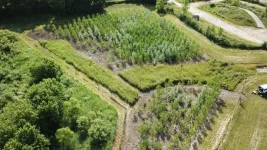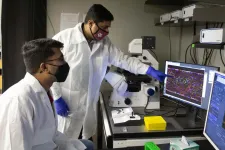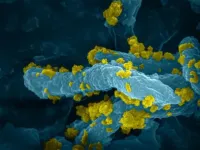INFORMATION:
Dangerous landfill pollutants ranked in order of toxicity by MU researchers
In partnership with the USDA Forest Service, University of Missouri researchers developed a system to prioritize most toxic pollutants.
2021-03-24
(Press-News.org) COLUMBIA, Mo. - Nearly 2,000 active landfills are spread across the U.S., with the majority of garbage discarded by homes and businesses finding its way to a landfill. The resulting chemicals and toxins that build up at these sites can then leach into soil and groundwater, and this "leachate" can present serious hazards to the environment and to the people who live nearby.
To help environmental agencies battle the toxic threats posed by landfills, researchers at the University of Missouri -- in partnership with the USDA Forest Service -- have developed a system that ranks the toxins present in a landfill by order of toxicity and quantity, allowing agencies to create more specific and efficient plans to combat leachate.
"Leachate from landfills can cause cancer and other serious harm, and it's a threat whether it's ingested, inhaled or touched," said Chung-Ho Lin, an associate research professor with the MU Center for Agroforestry in the College of Agriculture, Food and Natural Resources. "This is the first time a system has been created that can automatically prioritize the pollutants released from a landfill based on their toxicity and abundance."
The system relies on an algorithm created by Elizabeth Rogers, a doctoral student working under Lin's guidance at the University of Missouri and a USDA Pathways Intern. Rogers drew from a previously existing system designed to prioritize chemicals in "fracking" wastewater and adapted it to apply to landfill pollution.
Combining the algorithm with three "toxicity databases" that are referenced when analyzing a sample from a landfill, the system takes a traditionally time-consuming and expensive process -- identifying a pollutant and determining its abundance and potential harm -- and makes it routine. The result is a prioritization system that can rank pollutants by taking into account both their overall toxicity and prevalence at a given site. In addition, the prioritization of pollutants can be easily customized based on factors and goals that can vary from site to site.
Ronald Zalesny Jr., a supervisory research plant geneticist for the USDA Forest Service who is also mentoring Rogers, worked with Lin and Rogers on the study optimizing the prioritization system and exploring its utility. For him, the ability to easily identify, quantify and rank landfill pollutants meets a very real need.
Zalesny Jr. is a principal investigator for a project that harnesses trees to clean up contaminated soils and water at landfills. Through a natural process known as phytoremediation, the poplar and willow trees help degrade, absorb and otherwise inhibit pollutants and the groundwater runoff that carries them.
Knowing which pollutants are the most important targets at a given location is crucial, said Zalesny Jr., because different trees employ different methods of removing pollutants from the soil, and no single method will work on every type of pollutant.
"In the past, we have mostly targeted the most common pollutants, such as herbicides and contaminants from crude oil," Zalesny Jr. said. "Using this prioritization tool, we could now go to basically any contaminated site, identify the top contaminants and match those contaminants with our trees to create a sustainable, long-term solution for cleaning up pollution."
Zalesny Jr.'s project is part of the Great Lakes Restoration Initiative, which seeks to protect the Great Lakes from environmental degradation by providing relevant funding to federal agencies. If contaminated runoff from landfills makes its way into rivers and streams, it could ultimately make its way into the Great Lakes, Zalesny Jr. said.
Rogers, who created the algorithm that can quickly sort pollutants by their relative toxicity, sees another important benefit to the system. While many landfill regulations have not been updated in decades, new classes of contaminants continue to arrive in landfills, posing a problem for those seeking to mitigate their effects. By offering scientists and researchers up to date information about hundreds of possible pollutants, the prioritization system could help environmental agencies tackle more of these dangerous new arrivals.
"Some of the most potentially harmful compounds that we identified using this scheme were from things like antibiotics or prescription medications, which could have serious impacts on the human endocrine system," Rogers said. "There were also compounds from personal care products. And while we know these newer classes of compounds can have negative impacts, there is still a lot we don't know about them, and they're ending up in landfills. Hopefully the use of this system will encourage more research into their impacts."
ELSE PRESS RELEASES FROM THIS DATE:
A novel marker of adult human neural stem cells discovered
2021-03-24
HOUSTON - (Mar 24, 2021) -The mammalian center for learning and memory, hippocampus, has a remarkable capacity to generate new neurons throughout life. Newborn neurons are produced by neural stem cells (NSCs) and they are crucial for forming neural circuits required for learning and memory, and mood control. During aging, the number of NSCs declines, leading to decreased neurogenesis and age-associated cognitive decline, anxiety, and depression. Thus, identifying the core molecular machinery responsible for NSC preservation is of fundamental importance if we are to use neurogenesis to halt or reverse hippocampal age-related pathology.
While there are increasing number of tools available to study NSCs and neurogenesis in mouse models, one of the major ...
A better treatment for sickle cell disease
2021-03-24
Sickle cell disease is the most prevalent inherited blood disorder in the world, affecting 70,000 to 100,000 Americans. However, it is considered an orphan disease, meaning it impacts less than 200,000 people nationally, and is therefore underrepresented in therapeutic research.
A team led by Abhishek Jain from the Department of Biomedical Engineering at Texas A&M University is working to address this disease.
"I'm trying to create these new types of disease models that can impact health care, with the long-term goal of emphasizing on applying these tools ...
New research finds seating assignments on airplanes can reduce the spread of COVID-19
2021-03-24
>
CATONSVILLE, MD, March 24, 2021 - COVID-19 has been shown to spread on airplanes by infected passengers, so minimizing the risk of secondary infections aboard aircraft may save lives. New research in the INFORMS journal Service Science uses two models to help solve the airplane seating assignment problem (ASAP). The models can lower the transmission risk of COVID-19 more so than the strategy of blocking the middle seats, given the same number of passengers.
"Blocking the middle seat on an airplane may provide limited benefit in reducing the risk of transmission of COVID-19. Rather, other health protocols are better supported at preventing the transmission ...
New drug candidate against COVID-19
2021-03-24
SARS-CoV-2, the virus responsible for the COVID-19 pandemic, arrived one year ago and turned our lives upside-down.
While worldwide vaccination programs are currently ongoing, we do not yet know for how long the vaccine will provide immune protection against infection, and if the currently approved vaccines can provide protection against the emerging virus variants.
In addition, it appears that vaccines cannot prevent illness for people who have already been infected. In contrast to vaccines, there are currently no effective drugs that act against the virus SARS-CoV-2.
New research by Associate Professor Jasmin Mecinovic and co-workers from the Department of Physics, Chemistry and Pharmacy, University of Southern Denmark, now presents a compound that might provide a basis for the ...
Shining light to make hydrogen
2021-03-24
Decarbonizing the economy and achieving the transition from fossil fuels to renewable energies is one of the most urgent global challenges of the 21st century. Hydrogen can play a key role in this process as a promising climate-neutral energy vehicle. Yet, the so-called green hydrogen economy requires that hydrogen production be based exclusively on renewable energy. In addition, it should ideally not use expensive and rare metal catalysts, whose production has severe environmental consequences. To address this challenge, ITQB NOVA researchers Inês Cardoso Pereira and Mónica Martins are working on an innovative technology to produce hydrogen from light using non-photosynthetic microorganisms.
Hydrogen offers exciting new possibilities as an energy vehicle, ...
Black hole shows magnetic fields surrounding it are strong enough to resist gravity
2021-03-24
The Event Horizon Telescope (EHT) collaboration, a multinational team of over 300 scientists including two astrophysicists from the University of the Witwatersrand (Wits University), has revealed today a new view of the massive object at the centre of the M87 galaxy: how it looks in polarised light.
This is the first time astronomers have been able to measure polarisation, a signature of magnetic fields, this close to the edge of a black hole. The observations are key to explaining how the M87 galaxy, located 55 million light-years away, is able to launch energetic jets from its core.
"We are now seeing the next crucial piece of evidence to understand how magnetic fields behave around black holes, and how activity in this very compact region of space can drive powerful ...
Astronomers image magnetic fields at the edge of M87's black hole
2021-03-24
The Event Horizon Telescope (EHT) collaboration, who produced the first ever image of a black hole, has today revealed a new view of the massive object at the centre of the Messier 87 (M87) galaxy: how it looks in polarised light. This is the first time astronomers have been able to measure polarisation, a signature of magnetic fields, this close to the edge of a black hole. The observations are key to explaining how the M87 galaxy, located 55 million light-years away, is able to launch energetic jets from its core.
"We are now seeing the next crucial piece of evidence to understand ...
Positive self-image and self-esteem protects against weight gain in adolescence
2021-03-24
A new study from the University of Bergen (UiB) shows that the way young people view their bodies have a great impact on their BMI.
In a two-year follow up study among 1225 Norwegian adolescents in their early teens, professor Eivind Meland and his team examined how body mass index, self-esteem and self-rated health were mutually impacted and influenced by body dissatisfaction.
"We revealed that positive self-image and self-esteem protected against weight gain", professor emeritus Meland says.
The girls had in general lower body confidence than boys, the study shows.
Body dissatisfaction
The eager to be thinner, dieting, and wanting to change something with the body all impaired self-rated health ...
Want a healthier home? Start with your couch
2021-03-24
A new study shows that when people replace their old couch with a new one that has no added flame retardants, levels of the harmful chemicals in household dust drop significantly. Replacing the foam inside the couch cushions is also just as effective. The findings confirm that choosing healthier furniture without flame retardants can make a big difference in people's--especially children's--everyday exposures to these toxic chemicals.
"We've long suspected that couches are a major source of toxic chemicals in dust. Now, for the first time, we have evidence demonstrating the positive impacts of replacing old furniture containing flame retardants," ...
Effective Field Theories and the nature of the universe
2021-03-24
What is the world made of? This question, which goes back millennia, was revisited by theoretical physicist Steven Weinberg from the University of Texas in Austin, TX, USA in the first of an international seminar series, 'All Things EFT'. Weinberg's seminar has now been published as an article in the journal EPJ H.
And Weinberg is well placed to discuss both Effective Field Theories (EFTs) and the nature of the Universe, as he shared the 1979 Nobel Prize for Physics for developing a theory to unify the weak and electromagnetic interactions between elementary particles. This fed into the development of the ...
LAST 30 PRESS RELEASES:
Statins significantly reduce mortality risk for adults with diabetes, regardless of cardiovascular risk
Brain immune cells may drive more damage in females than males with Alzheimer’s
Evidence-based recommendations empower clinicians to manage epilepsy in pregnancy
Fungus turns bark beetles’ defenses against them
There are new antivirals being tested for herpesviruses. Scientists now know how they work
CDI scientist, colleagues author review of global burden of fungus Candida auris
How does stroke influence speech comprehension?
B cells transiently unlock their plasticity, risking lymphoma development
Advanced AI dodel predicts spoken language outcomes in deaf children after cochlear implants
Multimodal imaging-based cerebral blood flow prediction model development in simulated microgravity
Accelerated streaming subgraph matching framework is faster, more robust, and scalable
Gestational diabetes rose every year in the US since 2016
OHSU researchers find breast cancer drug boosts leukemia treatment
Fear and medical misinformation regarding risk of progression or recurrence among patients with breast cancer
Glucagonlike peptide-1 receptor agonists and asthma risk in adolescents with obesity
Reviving dormant immunity: Millimeter waves reprogram the immunosuppressive microenvironment to potentiate immunotherapy without obvious side effects
Safety decision-making for autonomous vehicles integrating passenger physiological states by fNIRS
Fires could emit more air pollution than previously estimated
A new way to map how cells choose their fate
Numbers in our sights affect how we perceive space
SIMJ announces global collaborative book project in commemoration of its 75th anniversary
Air pollution exposure and birth weight
Obstructive sleep apnea risk and mental health conditions among older adults
How talking slows eye movements behind the wheel
The Ceramic Society of Japan’s Oxoate Ceramics Research Association launches new international book project
Heart-brain connection: international study reveals the role of the vagus nerve in keeping the heart young
Researchers identify Rb1 as a predictive biomarker for a new therapeutic strategy in some breast cancers
Survey reveals ethical gaps slowing AI adoption in pediatric surgery
Stimulant ADHD medications work differently than thought
AI overestimates how smart people are, according to HSE economists
[Press-News.org] Dangerous landfill pollutants ranked in order of toxicity by MU researchersIn partnership with the USDA Forest Service, University of Missouri researchers developed a system to prioritize most toxic pollutants.





